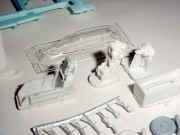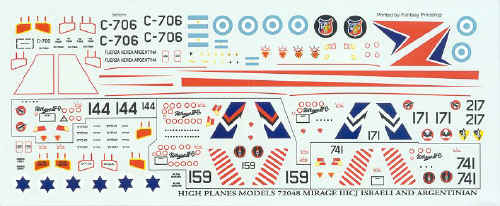|
The Mirage III, in all its versions, is a very well known plane among modelers. Therefore, I think it is not necessary to go into further details on its history.
What should be noticed is that the Australian company High Planes Models is offering a model of the only M III CJ currently in operation worldwide.
|
Kit presentation
High Planes offers us a multimedia kit with plastic injected parts according to the limited run standards, as well as white metal and resin parts. The canopy and windscreen, cast as an integral vacuformed part, do not show any scratches at all. This part should be carefully cut out, since only one unit is included!
|

|
All plastic parts, in an unusual light blue, have flashes that can be easily removed with a cutter without causing any damages to the parts.
The injected parts include: fuselage, wings, tail, undercarriage doors, and external fuel tanks, all of them with finely engraved panel lines and crisp surface details.
I decided to replace all antennas and undercarriage doors with plastic sheets.
The resin parts, very well cast and with crisp detailing include: exhaust nozzle with detailed interior, forward undercarriage wheel wells, cockpit tube, ejection seat and instrumental panel, bulged main wheels.
The undercarriage legs, pitot tube, control stick and undercarriage retraction jacks are cast in white metal with fine details adequate for this 1/72 scale.
|
Decals
The decals are very attractive at first sight, and a closer look at them reveals a perfect register, very good definition and density color. They are thin but not transparent. All these features make the decals one of the Highlights of this kit.
The decal sheet offers the possibility of seven different alternatives: 4 alternatives for the Israeli scheme (tricolor scheme or low visibility) plus another 3 corresponding to the Argentine Air Force.
|
|

|
If you want to apply the attractive white / red / blue paint scheme, you should paint the red and blue lines on the wings and the blue detailing on the fuselage (see photographs).
Please bear in mind that this plane has a very clean aspect so it is important to achieve a very slight weathering only limited to the serviceable panels.
Conclusion
Once you overcome the impression caused by the color of the plastic parts, the general quality of this kit is really good, especially the resin parts.
The instruction sheets include an explanation for the construction of this kit. Special attention should be paid to the item related to the modifications to be made to the rear part of the fuselage since, according to the selected version, the exhaust nozzles can be different.
These instructions also include a graphic scheme of the assembly and profiles corresponding to each version, with color references and decal placement.
For those modelers who usually build limited run models, this Mirage III is a good point of departure for super detailing. Beginners and intermediate modelers should decide whether or not they accept the challenge of building a model having these features.
|